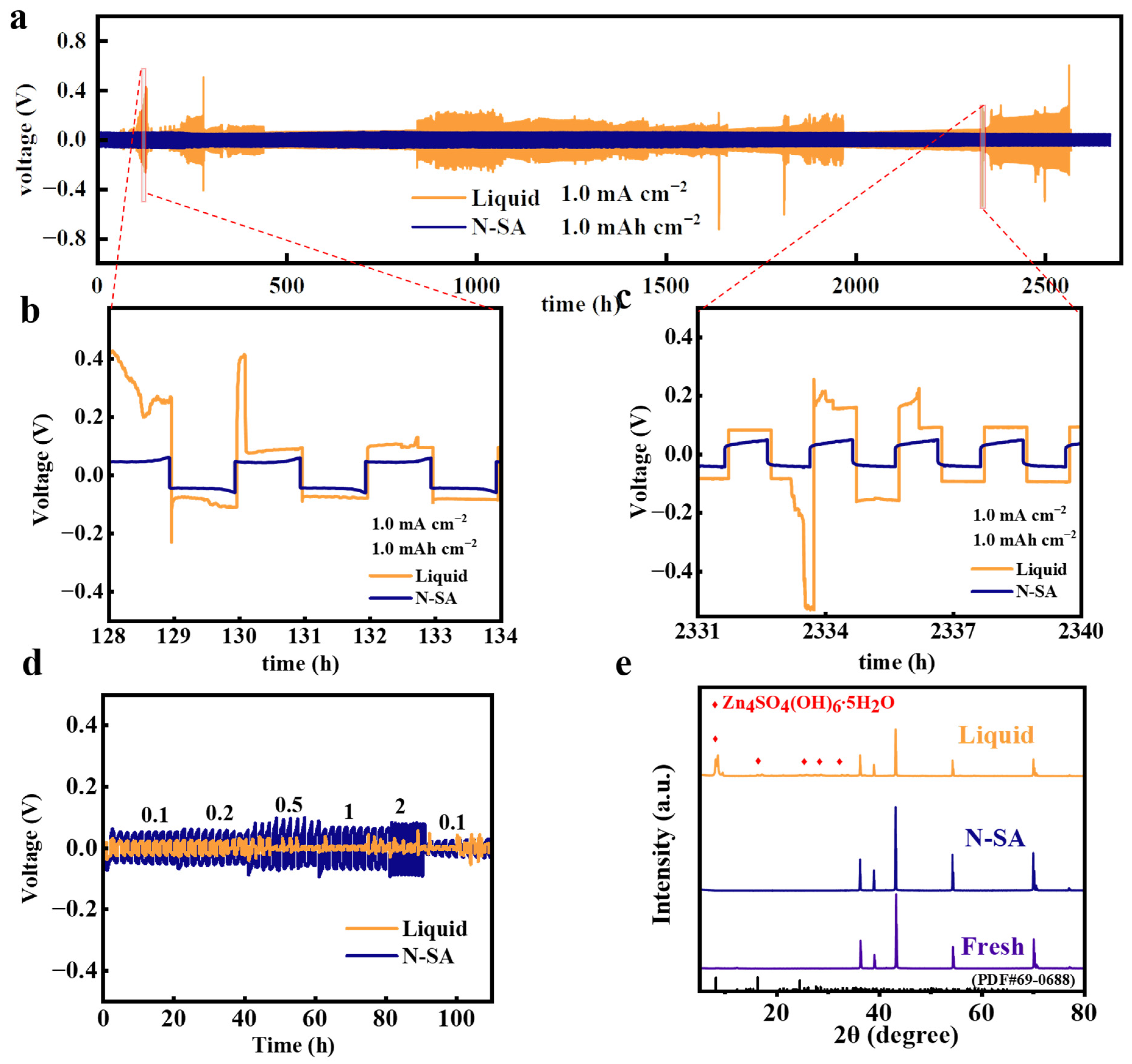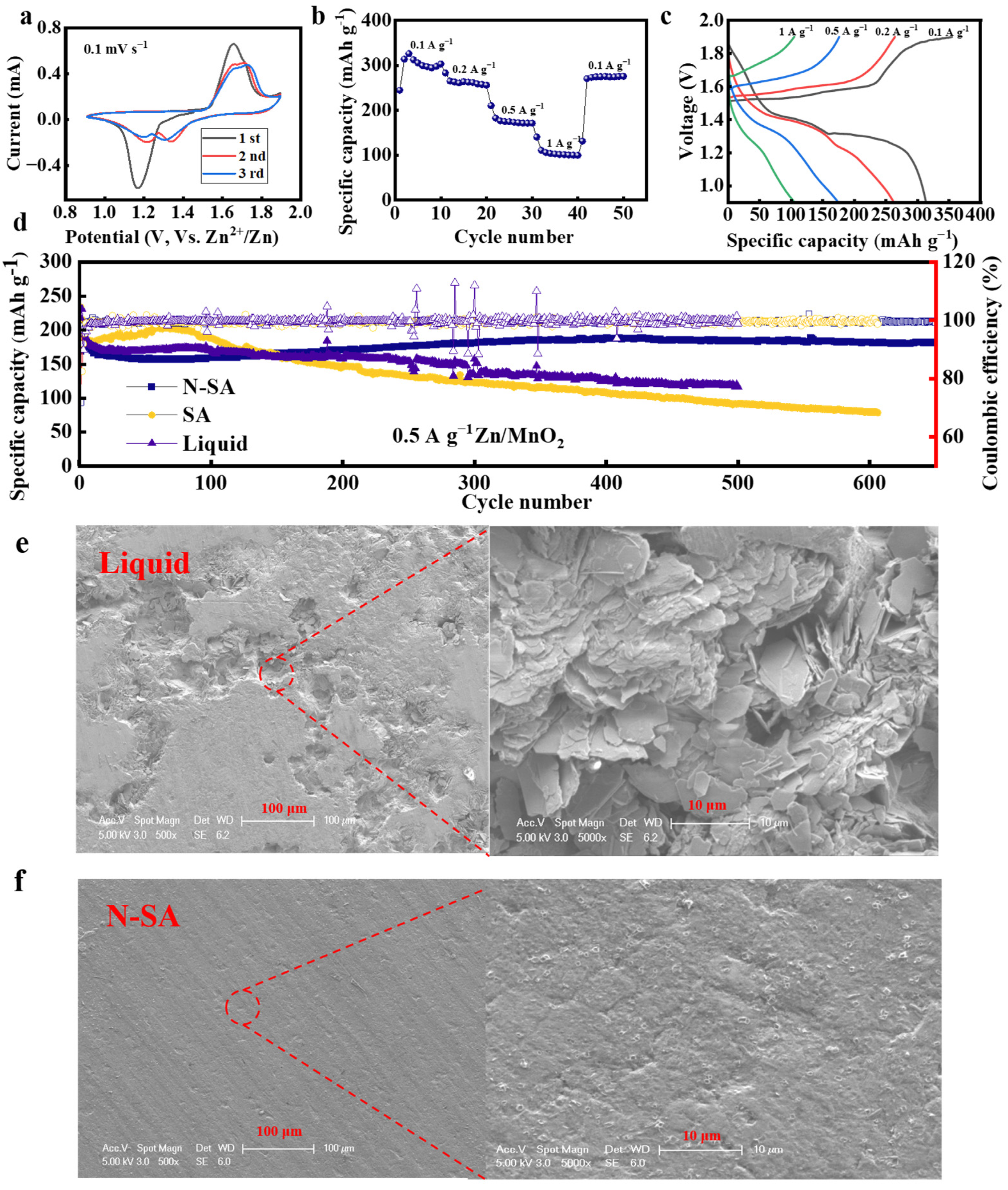Flexible and Stable N-Isopropylacrylamide/Sodium Alginate Gel Electrolytes for Aqueous Zn-MNO2 Batteries
Abstract
1. Introduction
2. Experimental Methods
2.1. Materials
2.2. Preparation of α-MnO2 Powders
2.3. Preparation of Electrolytes
2.4. Preparation of Electrode and Battery Assembly
2.5. Characterizations
3. Results and Discussion
4. Conclusions
Supplementary Materials
Author Contributions
Funding
Data Availability Statement
Conflicts of Interest
References
- Li, M.; Lu, J.; Chen, Z.; Amine, K. 30 Years of Lithium-Ion Batteries. Adv. Mater. 2018, 30, 1800561. [Google Scholar] [CrossRef] [PubMed]
- Tang, B.; Shan, L.; Liang, S.; Zhou, J. Issues and Opportunities Facing Aqueous Zinc-Ion Batteries. Energy Environ. Sci. 2019, 12, 3288–3304. [Google Scholar] [CrossRef]
- Xu, C.; Li, B.; Du, H.; Kang, F. Energetic Zinc Ion Chemistry: The Rechargeable Zinc Ion Battery. Angew. Chem. Int. Ed. 2012, 51, 933–935. [Google Scholar] [CrossRef]
- Michail, A.; Silván, B.; Tapia-Ruiz, N. Progress in High-Voltage MgMn2O4 Oxyspinel Cathode Materials for Mg Batteries. Curr. Opin. Electrochem. 2022, 31, 100817. [Google Scholar] [CrossRef]
- Fdz De Anastro, A.; Casado, N.; Wang, X.; Rehmen, J.; Evans, D.; Mecerreyes, D.; Forsyth, M.; Pozo-Gonzalo, C. Poly(Ionic Liquid) Iongels for All-Solid Rechargeable Zinc/PEDOT Batteries. Electrochim. Acta 2018, 278, 271–278. [Google Scholar] [CrossRef]
- Mainar, A.R.; Colmenares, L.C.; Blázquez, J.A.; Urdampilleta, I. A Brief Overview of Secondary Zinc Anode Development: The Key of Improving Zinc-Based Energy Storage Systems. Int. J. Energy Res. 2018, 42, 903–918. [Google Scholar] [CrossRef]
- Wang, R.; Yao, M.; Huang, S.; Tian, J.; Niu, Z. Sustainable Dough-Based Gel Electrolytes for Aqueous Energy Storage Devices. Adv. Funct. Mater. 2021, 31, 2009209. [Google Scholar] [CrossRef]
- Xue, T.; Fan, H.J. From Aqueous Zn-Ion Battery to Zn-MnO2 Flow Battery: A Brief Story. J. Energy Chem. 2021, 54, 194–201. [Google Scholar] [CrossRef]
- García-Gaitán, E.; Morant-Miñana, M.C.; Frattini, D.; Maddalena, L.; Fina, A.; Gerbaldi, C.; Cantero, I.; Ortiz-Vitoriano, N. Agarose-Based Gel Electrolytes for Sustainable Primary and Secondary Zinc-Air Batteries. Chem. Eng. J. 2023, 472, 144870. [Google Scholar] [CrossRef]
- Pu, X.; Jiang, B.; Wang, X.; Liu, W.; Dong, L.; Kang, F.; Xu, C. High-Performance Aqueous Zinc-Ion Batteries Realized by MOF Materials. Nano-Micro Lett. 2020, 12, 152. [Google Scholar] [CrossRef]
- Parker, J.F.; Chervin, C.N.; Pala, I.R.; Machler, M.; Burz, M.F.; Long, J.W.; Rolison, D.R. Rechargeable Nickel–3D Zinc Batteries: An Energy-Dense, Safer Alternative to Lithium-Ion. Science 2017, 356, 415–418. [Google Scholar] [CrossRef] [PubMed]
- Chen, M.; Zhou, W.; Wang, A.; Huang, A.; Chen, J.; Xu, J.; Wong, C.-P. Anti-Freezing Flexible Aqueous Zn–MnO2 Batteries Working at −35 °C Enabled by a Borax-Crosslinked Polyvinyl Alcohol/Glycerol Gel Electrolyte. J. Mater. Chem. A 2020, 8, 6828–6841. [Google Scholar] [CrossRef]
- Mo, F.; Liang, G.; Meng, Q.; Liu, Z.; Li, H.; Fan, J.; Zhi, C. A Flexible Rechargeable Aqueous Zinc Manganese-Dioxide Battery Working at −20 °C. Energy Environ. Sci. 2019, 12, 706–715. [Google Scholar] [CrossRef]
- Li, Q.; Cui, X.; Pan, Q. Self-Healable Hydrogel Electrolyte toward High-Performance and Reliable Quasi-Solid-State Zn–MnO2 Batteries. ACS Appl. Mater. Interfaces 2019, 11, 38762–38770. [Google Scholar] [CrossRef]
- Gaikwad, A.M.; Whiting, G.L.; Steingart, D.A.; Arias, A.C. Highly Flexible, Printed Alkaline Batteries Based on Mesh-Embedded Electrodes. Adv. Mater. 2011, 23, 3251–3255. [Google Scholar] [CrossRef]
- Jiang, D.; Lu, N.; Li, L.; Zhang, H.; Luan, J.; Wang, G. A Highly Compressible Hydrogel Electrolyte for Flexible Zn-MnO2 Battery. J. Colloid Interface Sci. 2022, 608, 1619–1626. [Google Scholar] [CrossRef]
- Wan, X.; Xie, Q.; Song, H.; Li, C.; Wang, J. Borax-Crosslinked Hydrogel Electrolyte Membranes for Quasi-Solid State Aqueous Energy Storage Devices. J. Membr. Sci. 2022, 655, 120606. [Google Scholar] [CrossRef]
- Yang, F.; Hua, H.; Lai, P.; Lin, P.; Yang, J.; Zhang, M.; Yang, Y.; Zhao, J. Synergetic Modulation of Ion Flux and Water Activity in a Single Zn2+ Conductor Hydrogel Electrolyte for Ultrastable Aqueous Zinc-Ion Batteries. ACS Appl. Energy Mater. 2022, 5, 10872–10882. [Google Scholar] [CrossRef]
- Tang, Y.; Liu, C.; Zhu, H.; Xie, X.; Gao, J.; Deng, C.; Han, M.; Liang, S.; Zhou, J. Ion-Confinement Effect Enabled by Gel Electrolyte for Highly Reversible Dendrite-Free Zinc Metal Anode. Energy Storage Mater. 2020, 27, 109–116. [Google Scholar] [CrossRef]
- Huang, Y.; Zhang, J.; Liu, J.; Li, Z.; Jin, S.; Li, Z.; Zhang, S.; Zhou, H. Flexible and Stable Quasi-Solid-State Zinc Ion Battery with Conductive Guar Gum Electrolyte. Mater. Today Energy 2019, 14, 100349. [Google Scholar] [CrossRef]
- Wang, Y.; Chen, Y. A Flexible Zinc-Ion Battery Based on the Optimized Concentrated Hydrogel Electrolyte for Enhanced Performance at Subzero Temperature. Electrochim. Acta 2021, 395, 139178. [Google Scholar] [CrossRef]
- Han, Q.; Chi, X.; Zhang, S.; Liu, Y.; Zhou, B.; Yang, J.; Liu, Y. Durable, Flexible Self-Standing Hydrogel Electrolytes Enabling High-Safety Rechargeable Solid-State Zinc Metal Batteries. J. Mater. Chem. A 2018, 6, 23046–23054. [Google Scholar] [CrossRef]
- Hu, O.; Chen, G.; Gu, J.; Lu, J.; Zhang, J.; Zhang, X.; Hou, L.; Jiang, X. A Facile Preparation Method for Anti-Freezing, Tough, Transparent, Conductive and Thermoplastic Poly(Vinyl Alcohol)/Sodium Alginate/Glycerol Organohydrogel Electrolyte. Int. J. Biol. Macromol. 2020, 164, 2512–2523. [Google Scholar] [CrossRef]
- Wang, J.; Huang, Y.; Liu, B.; Li, Z.; Zhang, J.; Yang, G.; Hiralal, P.; Jin, S.; Zhou, H. Flexible and Anti-Freezing Zinc-Ion Batteries Using a Guar-Gum/Sodium-Alginate/Ethylene-Glycol Hydrogel Electrolyte. Energy Storage Mater. 2021, 41, 599–605. [Google Scholar] [CrossRef]
- Dong, H.; Li, J.; Zhao, S.; Jiao, Y.; Chen, J.; Tan, Y.; Brett, D.J.L.; He, G.; Parkin, I.P. Investigation of a Biomass Hydrogel Electrolyte Naturally Stabilizing Cathodes for Zinc-Ion Batteries. ACS Appl. Mater. Interfaces 2021, 13, 745–754. [Google Scholar] [CrossRef] [PubMed]
- Lu, Y.; Zhu, T.; Xu, N.; Huang, K. A Semisolid Electrolyte for Flexible Zn-Ion Batteries. ACS Appl. Energy Mater. 2019, 2, 6904–6910. [Google Scholar] [CrossRef]
- Deng, W.; Zhou, Z.; Li, Y.; Zhang, M.; Yuan, X.; Hu, J.; Li, Z.; Li, C.; Li, R. High-Capacity Layered Magnesium Vanadate with Concentrated Gel Electrolyte toward High-Performance and Wide-Temperature Zinc-Ion Battery. ACS Nano 2020, 14, 15776–15785. [Google Scholar] [CrossRef]
- Shih, H.; Liu, H.-Y.; Lin, C.-C. Improving Gelation Efficiency and Cytocompatibility of Visible Light Polymerized Thiol-Norbornene Hydrogels via Addition of Soluble Tyrosine. Biomater. Sci. 2017, 5, 589–599. [Google Scholar] [CrossRef]
- Song, Z.; Ding, J.; Liu, B.; Liu, X.; Han, X.; Deng, Y.; Hu, W.; Zhong, C. A Rechargeable Zn–Air Battery with High Energy Efficiency and Long Life Enabled by a Highly Water-Retentive Gel Electrolyte with Reaction Modifier. Adv. Mater. 2020, 32, 1908127. [Google Scholar] [CrossRef]
- Lee, B.; Lee, H.R.; Kim, H.; Chung, K.Y.; Cho, B.W.; Oh, S.H. Elucidating the Intercalation Mechanism of Zinc Ions into α-MnO2 for Rechargeable Zinc Batteries. Chem. Commun. 2015, 51, 9265–9268. [Google Scholar] [CrossRef]
- Liu, Z.-F.; Zhu, C.-Y.; Ye, Y.-W.; Zhang, Y.-H.; Cheng, F.; Li, H.-R. Synergistic Optimization Strategy Involving Sandwich-like MnO2 @rGO and Laponite-Modified PAM for High-Performance Zinc-Ion Batteries and Zinc Dendrite Suppression. ACS Appl. Mater. Interfaces 2022, 14, 25962–25971. [Google Scholar] [CrossRef]
- Zeng, X.; Meng, X.; Jiang, W.; Ling, M.; Yan, L.; Liang, C. In-Situ Constructing Polyacrylamide Interphase Enables Dendrite-Free Zinc Anode in Aqueous Batteries. Electrochim. Acta 2021, 378, 138106. [Google Scholar] [CrossRef]
- Hu, Y.; Shen, P.; Zeng, N.; Wang, L.; Yan, D.; Cui, L.; Yang, K.; Zhai, C. Hybrid Hydrogel Electrolyte Based on Metal–Organic Supermolecular Self-Assembly and Polymer Chemical Cross-Linking for Rechargeable Aqueous Zn–MnO2 Batteries. ACS Appl. Mater. Interfaces 2020, 12, 42285–42293. [Google Scholar] [CrossRef]
- Ma, L.; Schroeder, M.A.; Borodin, O.; Pollard, T.P.; Ding, M.S.; Wang, C.; Xu, K. Realizing High Zinc Reversibility in Rechargeable Batteries. Nat. Energy 2020, 5, 743–749. [Google Scholar] [CrossRef]
- Wei, T.; Ren, Y.; Li, Z.; Zhang, X.; Ji, D.; Hu, L. Bonding Interaction Regulation in Hydrogel Electrolyte Enable Dendrite-Free Aqueous Zinc-Ion Batteries from −20 to 60 °C. Chem. Eng. J. 2022, 434, 134646. [Google Scholar] [CrossRef]
- Ma, L.; Chen, S.; Li, N.; Liu, Z.; Tang, Z.; Zapien, J.A.; Chen, S.; Fan, J.; Zhi, C. Hydrogen-Free and Dendrite-Free All-Solid-State Zn-Ion Batteries. Adv. Mater. 2020, 32, 1908121. [Google Scholar] [CrossRef]
- Hong, Z.; Ahmad, Z.; Viswanathan, V. Design Principles for Dendrite Suppression with Porous Polymer/Aqueous Solution Hybrid Electrolyte for Zn Metal Anodes. ACS Energy Lett. 2020, 5, 2466–2474. [Google Scholar] [CrossRef]
- Kim, J.Y.; Liu, G.; Shim, G.Y.; Kim, H.; Lee, J.K. Functionalized Zn@ZnO Hexagonal Pyramid Array for Dendrite-Free and Ultrastable Zinc Metal Anodes. Adv. Funct. Mater. 2020, 30, 2004210. [Google Scholar] [CrossRef]
- Kundu, D.; Hosseini Vajargah, S.; Wan, L.; Adams, B.; Prendergast, D.; Nazar, L.F. Aqueous vs. Nonaqueous Zn-Ion Batteries: Consequences of the Desolvation Penalty at the Interface. Energy Environ. Sci. 2018, 11, 881–892. [Google Scholar] [CrossRef]
- Pan, H.; Shao, Y.; Yan, P.; Cheng, Y.; Han, K.S.; Nie, Z.; Wang, C.; Yang, J.; Li, X.; Bhattacharya, P.; et al. Reversible Aqueous Zinc/Manganese Oxide Energy Storage from Conversion Reactions. Nat. Energy 2020, 5, 743–749. [Google Scholar] [CrossRef]
- Wang, S.; Yuan, Z.; Zhang, X.; Bi, S.; Zhou, Z.; Tian, J.; Zhang, Q.; Niu, Z. Non-Metal Ion Co-Insertion Chemistry in Aqueous Zn/MnO2 Batteries. Angew. Chem. Int. Ed. 2021, 60, 7056–7060. [Google Scholar] [CrossRef] [PubMed]





Disclaimer/Publisher’s Note: The statements, opinions and data contained in all publications are solely those of the individual author(s) and contributor(s) and not of MDPI and/or the editor(s). MDPI and/or the editor(s) disclaim responsibility for any injury to people or property resulting from any ideas, methods, instructions or products referred to in the content. |
© 2023 by the authors. Licensee MDPI, Basel, Switzerland. This article is an open access article distributed under the terms and conditions of the Creative Commons Attribution (CC BY) license (https://creativecommons.org/licenses/by/4.0/).
Share and Cite
Wang, K.; Shangguan, M.; Zhao, Y.; Tian, H.; Wang, F.; Yuan, J.; Xia, L. Flexible and Stable N-Isopropylacrylamide/Sodium Alginate Gel Electrolytes for Aqueous Zn-MNO2 Batteries. Batteries 2023, 9, 426. https://doi.org/10.3390/batteries9080426
Wang K, Shangguan M, Zhao Y, Tian H, Wang F, Yuan J, Xia L. Flexible and Stable N-Isopropylacrylamide/Sodium Alginate Gel Electrolytes for Aqueous Zn-MNO2 Batteries. Batteries. 2023; 9(8):426. https://doi.org/10.3390/batteries9080426
Chicago/Turabian StyleWang, Kehuang, Mingliang Shangguan, Yibo Zhao, Haoran Tian, Fu Wang, Jinliang Yuan, and Lan Xia. 2023. "Flexible and Stable N-Isopropylacrylamide/Sodium Alginate Gel Electrolytes for Aqueous Zn-MNO2 Batteries" Batteries 9, no. 8: 426. https://doi.org/10.3390/batteries9080426
APA StyleWang, K., Shangguan, M., Zhao, Y., Tian, H., Wang, F., Yuan, J., & Xia, L. (2023). Flexible and Stable N-Isopropylacrylamide/Sodium Alginate Gel Electrolytes for Aqueous Zn-MNO2 Batteries. Batteries, 9(8), 426. https://doi.org/10.3390/batteries9080426







